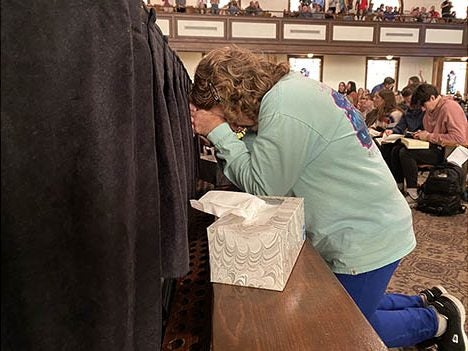Measles case tied to Asbury revival
Published 12:40 pm Tuesday, February 28, 2023

- File photo. (Photo by Gillian Stawiszynski)
|
Getting your Trinity Audio player ready...
|
Staff Report
The Jessamine County Health Department (JCHD) has received a report of a laboratory-confirmed measles case in Jessamine County from an individual who attended the recent revival held on the campus of Asbury University in Wilmore.
The attendee, whose identity will not be released for privacy reasons, attended the revival on Feb. 18.
The revival drew thousands to Hughes Auditorium on the campus of the Wilmore school.
Health officials urge anyone who may have been exposed to check their immunization records and confirm they are protected against measles. Kentucky residents can access their immunization records through the Kentucky Immunization Registry Public Portal at https://www.chfs.ky.gov/KDPHMyVaxRecord
“Measles is an acute, highly contagious viral disease which can spread quickly in high-risk, unvaccinated populations,” said Dr. Steve Davis, JCHD Medical Director.
Symptoms include fever; runny nose, cough, red and watery eyes and a rash.
Although measles is usually considered a childhood disease, it can be contracted at any age.
Anyone who has been exposed and has not been adequately immunized against measles is being urged by the health department to quarantine for twenty-one (21) days following exposure, per the Centers for Disease Control and Prevention (CDC).
JCHD said it will continue to receive guidance from the Kentucky Department for Public Health and the CDC to ensure proper precautions are taking place to mitigate further spread.
The health department is working with Asbury health officials to coordinate a measles vaccine clinic next week. More information will be released as details are finalized.
How to recognize symptoms and more
At first, measles symptoms look like cold symptoms. According to the CDC website, these symptoms show 7 to 14 days after a measles infection: High fever, cough, runny nose and red, watery eyes.
Two to three days after the first symptoms show, the infected individual may begin to have tiny white spots, also known as Koplik spots, appear in their mouth.
Three to five days after symptoms begin, the measles rash begins. “It usually begins as flat red spots that appear on the face at the hairline and spread downward to the neck, trunk, arms, legs and feet,” reads the CDC website.
Small bumps may also form on the flat red spots, and the spots may merge as they spread from the head to the rest of the body. When the measles rash shows, a person’s fever may spike to more than 104 degrees Fahrenheit.
Individuals who have received the measles vaccination are better protected than those who are unvaccinated. The measles, mumps and rubella (MMR) vaccine is about 97% if exposed to the virus, according to Kentucky.gov.
However, there are certain populations more susceptible to facing severe complications after contracting measles, even if vaccinated.
These populations include children younger than five years old, adults older than 20 years old, pregnant people and people with compromised immune systems, such as from leukemia or HIV infection.
The following are some of the severe complications possible, per the CDC website:
• Hospitalization. About one in five unvaccinated people in the U.S. who get measles are hospitalized.
• Pneumonia. As many as one out of every 20 children with measles gets pneumonia, the most common cause of death from measles in young children.
• Encephalitis. About one child out of every 1,000 who get measles will develop encephalitis (swelling of the brain) that can lead to convulsions and can leave the child deaf or with an intellectual disability.
• Death. Nearly one to three of every 1,000 children who become infected with measles will die from respiratory and neurologic complications.
• Complications during pregnancy. Measles may cause pregnant people without the MMR vaccine to give birth prematurely or have a low-birth-weight baby.
For more information on measles, visit https://www.cdc.gov/measles




